Flying cameras have revolutionized skateboarding videography, offering epic ways to capture the sport's energy. You can use follow-the-skater aerial tracking for smooth, dynamic footage or create bird's-eye view trick shots for unique perspectives. Try low-altitude park fly-throughs for an immersive experience or rotating spiral descents for breathtaking aerial views. High-speed chase sequences capture raw energy, while obstacle course weaving adds excitement. Don't forget dramatic slow-motion captures, 360-degree panoramic spins, and synchronous multi-drone formations for spectacular effects. These techniques will elevate your skateboarding footage to new heights. Discover how to master these advanced methods and take your videos to the next level.
Follow-the-Skater Aerial Tracking
Innovation in skateboarding videography has taken flight with follow-the-skater aerial tracking. This cutting-edge technique uses drones or other flying cameras to automatically track and film skaters as they perform tricks and navigate obstacles.
You'll capture smooth, dynamic footage that follows your every move, providing a unique perspective that was previously impossible to achieve.
To use this technology, you'll need a drone equipped with object tracking capabilities. These smart flying cameras use advanced algorithms to lock onto you as the subject, maintaining a consistent distance and angle while you skate.
You can set the drone to follow from behind, alongside, or even circle around you as you ride.
The result is breathtaking footage that showcases your skills from an entirely new vantage point. You'll be able to capture long, uninterrupted shots of your runs, highlighting the flow and continuity of your skating.
This aerial tracking also allows you to film in locations that might be difficult or dangerous for a human camera operator to access, opening up new possibilities for creative skateboarding videos.
Bird's-Eye View Trick Shots

You'll be amazed by the stunning bird's-eye view trick shots that flying cameras can capture.
With aerial 360-degree flip captures, you'll witness skaters' rotations from above, while top-down rail grind shots offer a unique perspective on technical skills.
Swooping ollie sequences let you experience the height and trajectory of jumps in a way that ground-level cameras simply can't match.
Aerial 360-Degree Flip Capture
Soaring above the skatepark, drones capture breathtaking 360-degree views of skaters performing aerial flips. You'll witness gravity-defying stunts from every angle as the camera rotates mid-air, tracking the skater's trajectory. This technique allows you to showcase the full complexity of tricks like backflips, frontflips, and corkscrews.
To achieve the perfect aerial 360-degree flip capture, you'll need:
- A high-quality drone with obstacle avoidance and smooth rotation capabilities
- A 360-degree camera with excellent image stabilization
- A skilled drone pilot who can anticipate the skater's movements
- Proper coordination between the skater and the drone operator
- Post-production software to stitch and edit the footage seamlessly
As the skater launches into the air, the drone circles them, maintaining a consistent distance. The 360-degree camera records every moment of the flip, from take-off to landing.
You can then manipulate the footage in post-production, creating dynamic changes and unique perspectives that were once impossible to achieve. This technique not only captures the trick itself but also showcases the skater's form, style, and the surrounding environment in a single, immersive shot.
Top-Down Rail Grind Shots
While aerial shots capture the excitement of midair tricks, top-down rail grind shots offer a unique perspective on one of skateboarding's most iconic techniques.
You'll want to position your drone directly above the rail, creating a bird's-eye view that showcases the skater's balance and precision. This angle emphasizes the narrow path of the rail and the skater's trajectory, highlighting the skill required to maintain control.
To nail this shot, you'll need to coordinate closely with the skater. Communicate the planned route and timing, ensuring your drone is in position before the grind begins.
You'll want to fly at a consistent height, typically between 10 to 20 feet above the rail, depending on the length of the grind and your camera's field of view.
Consider using a wider lens to capture more of the surrounding area, providing context for the trick. As you film, follow the skater's movement smoothly, maintaining a steady frame rate to avoid jerky footage.
Don't forget to adjust your camera settings for ideal exposure, as the top-down angle can create challenging lighting conditions.
With practice, you'll master this technique, adding a compelling visual element to your skateboarding videos.
Swooping Ollie Sequences
Few skateboarding tricks capture the imagination quite like the ollie, and filming it from a bird's-eye view adds a whole new dimension to this classic move. With a flying camera, you'll be able to capture the entire sequence of an ollie in stunning detail, from takeoff to landing.
To create a swooping ollie sequence, position your drone above the skater and follow their movement. As they approach the ollie spot, start descending the camera while maintaining focus on the board. This creates a dynamic shot that emphasizes the height and distance of the trick.
Here's what you'll see in a well-executed swooping ollie sequence:
- The skater's initial approach and foot positioning
- The explosive pop of the tail hitting the ground
- The board leveling out at the peak of the ollie
- The skater's feet guiding the board back down
- The smooth landing and roll-away
Low-Altitude Park Fly-Throughs
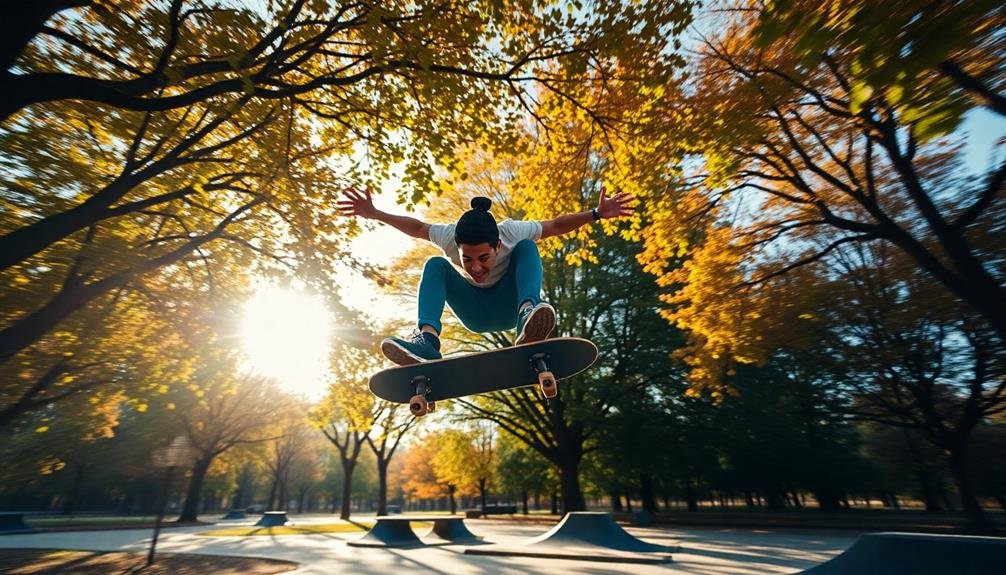
Low-altitude park fly-throughs offer skateboarders a unique way to capture their runs. You'll want to use a small, agile drone that can navigate tight spaces and follow you closely.
Start by mapping out your route through the park, identifying obstacles and potential hazards for both you and the drone.
Begin your run with the drone following behind you at about chest height. As you approach ramps or obstacles, program the drone to ascend slightly, giving viewers a bird's-eye perspective of your tricks.
For rail slides or grinds, have the drone fly alongside you, capturing your balance and technique from a lateral angle.
When you're tackling bowls or half-pipes, set the drone to orbit around you, providing a 360-degree view of your movements. For long, straight runs, try alternating between leading and trailing shots to add variety to your footage.
Remember to maintain a safe distance between you and the drone at all times. Practice your routes without the drone first to guarantee smooth flying and skating.
With some planning and coordination, you'll create stunning, immersive footage that showcases your skills and the park's layout in a whole new light.
Rotating Spiral Descents
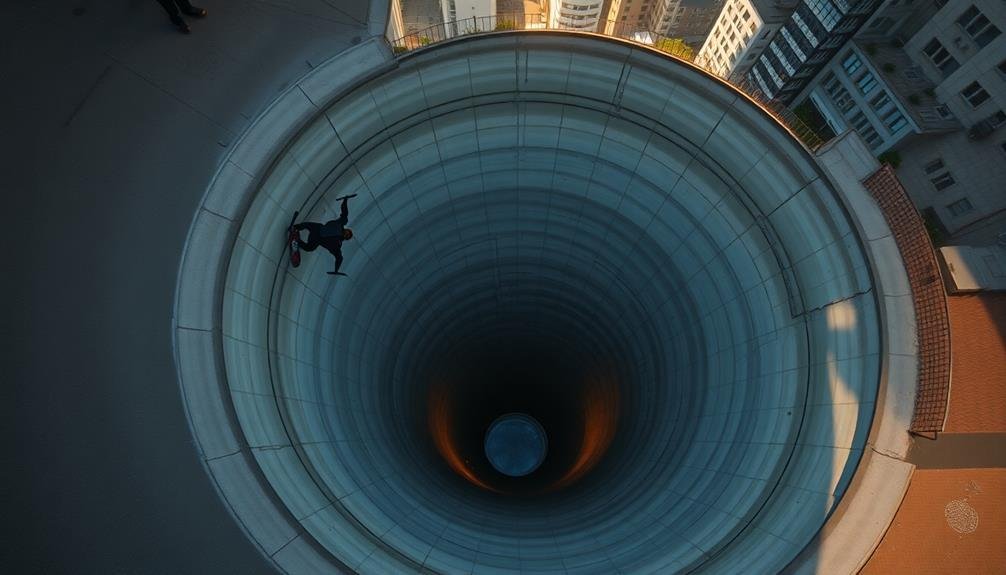
Rotating spiral descents often create breathtaking footage for skateboarding videos. You'll want to practice this technique to capture stunning aerial shots that showcase both the skater's skills and the surrounding environment.
As your drone spirals downward, it'll create a dizzying yet enthralling effect that draws viewers into the action.
To execute a perfect rotating spiral descent, you'll need to:
- Start at a high altitude, typically 100-150 feet above the skater
- Slowly decrease altitude while rotating the drone clockwise or counterclockwise
- Maintain a consistent speed for both descent and rotation
- Keep the skater centered in the frame throughout the maneuver
- End the spiral just as the skater completes their trick or reaches their destination
You'll find that this technique works best in open areas with minimal obstacles. It's ideal for capturing long runs, complex trick sequences, or shifts between different park sections.
Remember to adjust your camera settings to account for the changing perspective and lighting conditions as you descend. With practice, you'll be able to time your spiral perfectly with the skater's movements, creating a seamless and dynamic shot that elevates your skateboarding videos to new heights.
High-Speed Chase Sequences
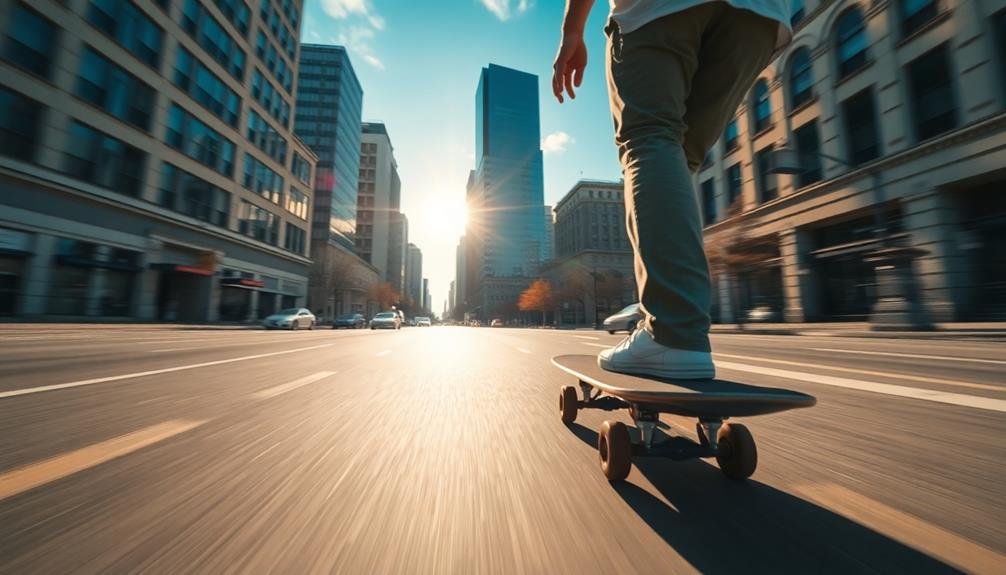
Adrenaline pumps as you execute high-speed chase sequences with your drone, capturing the raw energy of skateboarding in motion.
You'll need to master precise control and anticipate the skater's movements to keep them in frame while zooming alongside at breakneck speeds.
Start by positioning your drone slightly behind and above the skater. As they take off, accelerate your drone to match their pace.
Maintain a consistent distance, adjusting your altitude and angle to capture the most dynamic shots. Use your drone's sport mode for increased responsiveness and speed.
Navigate obstacles like trees, buildings, or other skaters by planning your route in advance.
Practice flying through tight spaces to improve your precision.
Experiment with different angles – low shots emphasize speed, while higher angles showcase the surrounding environment.
For added drama, incorporate quick pans or tilts as the skater performs tricks.
Time these movements to coincide with key moments in their run.
Don't forget to capture the skater's facial expressions and body language to convey the intensity of the chase.
Remember to prioritize safety.
Always maintain visual contact with your drone and respect local regulations.
Vertical Ascent Trick Reveals
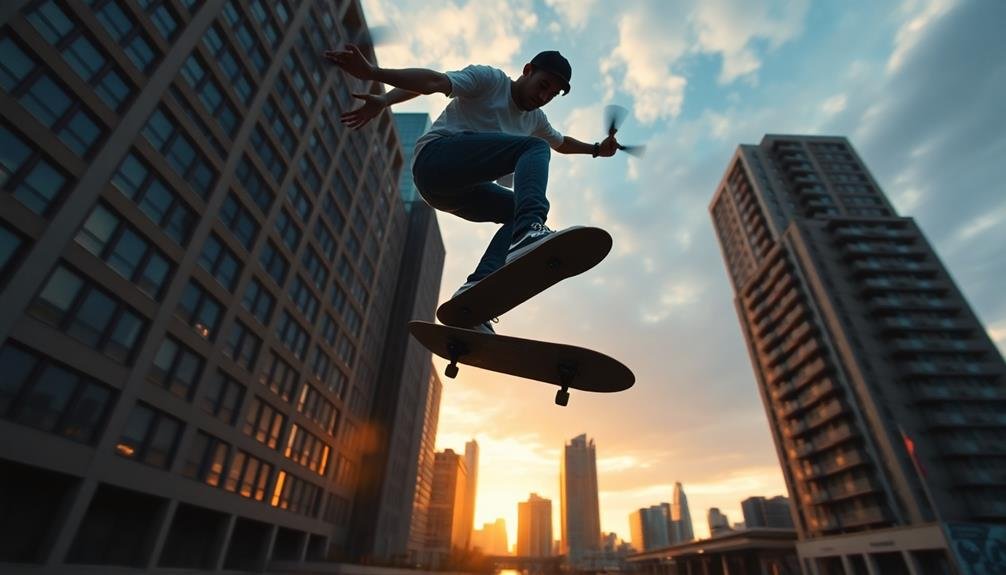
You'll witness skateboarding tricks from an entirely new perspective as flying cameras ascend alongside vertical maneuvers.
These aerial views offer a bird's-eye progression of complex tricks, revealing intricate details often missed from ground-level angles.
As you master the art of ascending camera angles, you'll capture the full scope of vertical skateboarding feats, from takeoff to landing, in breathtaking sequences.
Bird's-Eye Trick Progression
As the drone ascends vertically, it reveals a mesmerizing sequence of skateboarding tricks from an entirely new perspective. You'll capture a bird's-eye view of the skater's progression, showcasing their skill development in a unique and visually stunning way. This technique allows you to film multiple tricks in a single, continuous shot, creating a compelling narrative of the skater's journey.
To execute this shot effectively, you'll need to:
- Position the drone directly above the skater
- Start low, just a few feet off the ground
- Slowly ascend as the skater performs each trick
- Maintain a steady vertical climb throughout the sequence
- End at a height that captures the entire skate area
As you film, you'll see the skater's movements become smaller and more intricate from above. The ascending view adds depth and context to the tricks, revealing how they flow together and utilize the surrounding space.
This technique works particularly well for filming lines or sequences in skateparks, where the layout and obstacles become more apparent as the drone rises. You'll create a dynamic and engaging visual story that showcases both the skater's skills and the environment they're conquering.
Ascending Camera Angle Mastery
Mastering the ascending camera angle technique requires practice and precision. You'll need to synchronize your drone's vertical ascent with your skateboarding trick execution.
Start by positioning your drone low to the ground, just behind you as you prepare for your trick. As you begin your move, initiate the drone's ascent.
The key is to time the drone's rise to capture your trick's progression from ground level to its apex. You'll want to adjust the ascent speed based on the trick's duration. For quick tricks like ollies, use a faster ascent. For longer tricks like flip variations, slow down the drone's climb.
Experiment with different heights and distances. Try starting closer to yourself for intimate shots, then gradually increase the distance for a wider perspective.
Practice varying the drone's speed mid-ascent to emphasize specific moments in your trick.
Don't forget to take into account your surroundings. Use the ascending angle to reveal interesting backdrops or urban landscapes as your trick unfolds.
This technique can add depth and context to your skateboarding footage, creating visually stunning reveals that enhance your trick's impact.
Obstacle Course Weaving

Once you've mastered basic drone control, obstacle course weaving takes your skateboarding footage to the next level. This technique involves flying your drone through a series of obstacles while following a skateboarder, creating dynamic and thrilling shots.
To set up an obstacle course, use everyday objects or purpose-built drone gates. Consider the following elements:
- Trees or lamp posts for slalom-style weaving
- Low-hanging branches or banners for vertical challenges
- Narrow gaps between buildings or fences
- Ramps or quarter pipes for sudden elevation changes
- Tunnels or bridges for dramatic reveals
Start with simple patterns and gradually increase complexity as you improve. Practice flying through the course without a skateboarder first, then introduce the moving subject.
Coordinate with your skater to time their tricks with your drone's movements for maximum impact. Remember to maintain a safe distance from your subject and obstacles.
Use obstacle avoidance features if your drone has them, but don't rely on them entirely. Keep your shots smooth by using gentle stick movements and anticipating turns.
With practice, you'll create enchanting footage that showcases both your piloting skills and the skateboarder's talents in a unique, immersive way.
Dramatic Slow-Motion Captures
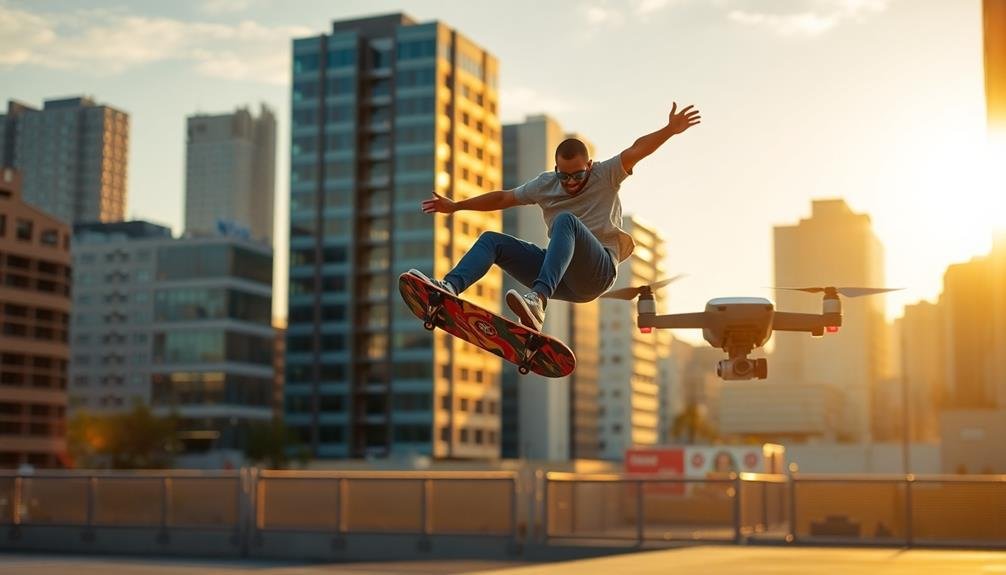
In addition to fast-paced action shots, dramatic slow-motion captures can elevate your skateboarding footage to cinematic levels. With flying cameras, you'll reveal new possibilities for creating stunning slo-mo sequences. To achieve the best results, you'll need a drone capable of high frame rates, typically 120fps or higher.
Position your drone to capture key moments, like the apex of an ollie or the instant before landing a trick. You can also use it to follow the skater's trajectory, creating a fluid, suspended-in-time effect. When filming, guarantee you're shooting in a well-lit environment to maintain image quality at higher frame rates.
In post-production, you'll slow down your footage to create the desired effect. Experiment with different speeds to find the perfect balance between showcasing the trick's intricacies and maintaining visual interest. Consider adding subtle camera movements in editing to enhance the sense of depth and dimension.
Combine slow-motion captures with normal-speed footage for a dynamic edit. This contrast will emphasize the most impressive moments and keep your audience engaged.
360-Degree Panoramic Spins
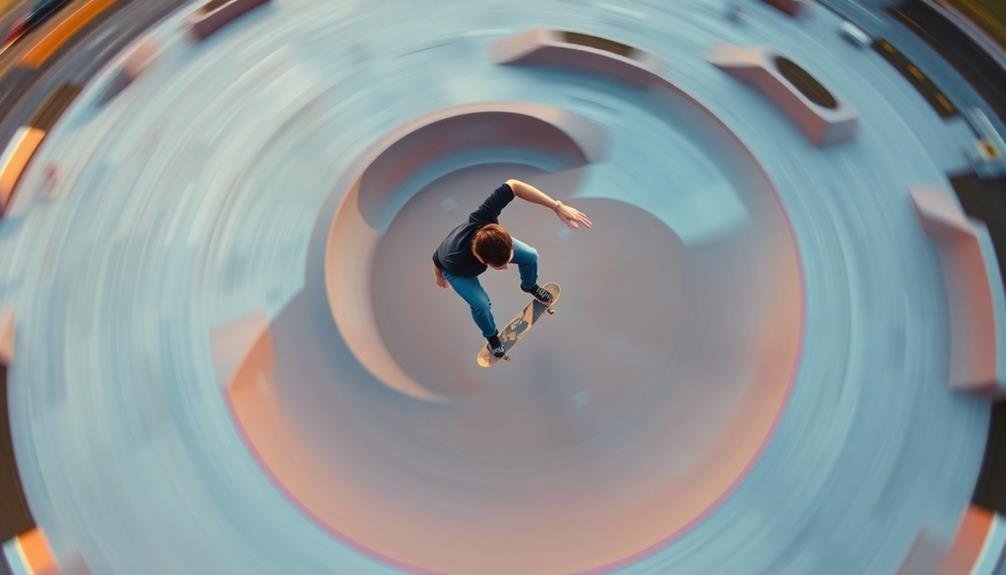
Flying cameras open up a world of possibilities for capturing stunning 360-degree panoramic spins in skateboarding videos. You can now showcase the entire environment surrounding a skater as they perform tricks, giving viewers a complete immersive experience.
These panoramic spins offer a unique perspective that's impossible to achieve with traditional filming methods.
To create the perfect 360-degree spin, you'll need to take into account several factors:
- Altitude: Position your drone at the right height to capture both the skater and their surroundings
- Speed: Adjust the rotation speed to match the pace of the trick being performed
- Timing: Sync the spin with the skater's movements for maximum impact
- Lighting: Guarantee even lighting throughout the rotation to avoid harsh shadows
- Stabilization: Use advanced stabilization features to keep the footage smooth
You can use these spins to highlight key moments in a skate video, such as when a skater lands a difficult trick or reaches the apex of a ramp.
They're also great for establishing shots, giving viewers a sense of the skate park's layout or the urban environment where the action takes place.
With practice, you'll master this technique and create truly fascinating skateboarding footage.
Synchronous Multi-Drone Formations

You'll be amazed by the coordinated flight patterns of multiple drones working in perfect harmony.
These synchronized camera movements create spectacular aerial perspectives that capture your skateboarding tricks from every angle.
With precise control, you can orchestrate a swarm of flying cameras to follow your moves, offering a cinematic experience that was once reserved for professional film productions.
Coordinated Flight Patterns
Synchronized drone formations add a new dimension to skateboarding videography. You'll create stunning visual effects by coordinating multiple drones to fly in specific patterns while filming.
These coordinated flight patterns can capture your tricks from various angles simultaneously, providing a dynamic and immersive viewing experience.
To achieve impressive coordinated flight patterns, you'll need to:
- Plan your formations carefully, considering the skatepark layout
- Synchronize drone movements with the skater's tricks and trajectory
- Use GPS-enabled drones for precise positioning and formation control
- Implement collision avoidance systems to prevent mid-air accidents
- Practice formations extensively before attempting complex shots
Synchronized Camera Movements
How can you elevate your skateboarding footage to the next level? Synchronized camera movements using multiple drones offer a game-changing approach to capturing your tricks. By coordinating a fleet of flying cameras, you'll create dynamic, multi-angle shots that bring your skateboarding to life.
Start by programming your drones to move in unison, creating a choreographed dance around you as you skate. Set up one drone for a wide establishing shot, another for close-ups, and a third for tracking your movements. As you perform tricks, the drones will smoothly shift between positions, capturing every angle simultaneously.
You can also experiment with swarm patterns, where multiple drones move in formation to create unique visual effects. Try a circular pattern that rotates around you during a trick, or a vertical stack that captures your jump from various heights.
For long runs, program your drones to leapfrog each other, ensuring continuous coverage without interruption.
Don't forget to synchronize your drones' camera settings for consistent exposure and color grading. This cohesive approach will result in seamless editing and a professional-looking final product that showcases your skateboarding skills from every imaginable angle.
Spectacular Aerial Perspectives
In light of the advancements in drone technology, spectacular aerial perspectives have become a game-changer for skateboarding videography. You can now capture breathtaking shots that were once impossible, showcasing your skills from entirely new angles.
By using synchronous multi-drone formations, you'll create a cinematic experience that'll leave viewers in awe.
Imagine a fleet of drones working in harmony to capture your skateboarding prowess. Here's what you can achieve:
- Circular formations that spiral around you as you perform tricks
- Vertical stacks that capture your moves from different altitudes simultaneously
- Choreographed swarm movements that follow your path through a skate park
- Panoramic shots that seamlessly shift from wide angles to close-ups
- Dynamic chase sequences that track your speed and agility
These aerial perspectives will add depth and dimension to your skateboarding videos, highlighting the complexity of your tricks and the intensity of your performance.
You'll be able to showcase the full scope of your environment, from expansive skate parks to urban landscapes. With multi-drone formations, you're not just filming skateboarding; you're creating an immersive visual experience that captures the essence of your sport.
Frequently Asked Questions
What Drone Regulations Apply When Filming Skateboarding in Public Spaces?
You'll need to follow local drone laws when filming skateboarding in public. Register your drone, stay under weight limits, avoid restricted areas, maintain visual line of sight, and respect privacy. Check FAA regulations for specific rules.
How Do Weather Conditions Affect Flying Camera Performance for Skateboard Filming?
Weather greatly impacts your flying camera's performance. Wind can destabilize shots, while rain damages electronics. Cold reduces battery life. Bright sun causes glare. You'll need to adjust settings and flight patterns for different conditions.
What Safety Precautions Should Be Taken When Using Drones Around Skateboarders?
When using drones around skateboarders, you'll need to prioritize safety. Keep your distance, fly at a safe height, and always maintain visual contact. Don't forget to brief skaters on drone presence and potential hazards.
Are There Specific Drone Models Best Suited for Skateboarding Cinematography?
You'll want to contemplate drones like the DJI Mavic Air 2 or FPV for skateboarding cinematography. They're compact, agile, and offer high-quality video. Look for models with obstacle avoidance and follow-me modes for the best results.
How Can Skateboard Filmmakers Learn to Pilot Drones for Advanced Shots?
You'll want to start with beginner-friendly drones and practice basic maneuvers. Take online courses, join local drone groups, and watch tutorials. Gradually progress to more complex moves, always prioritizing safety and following local regulations. It's a skill that takes time.
In Summary
You've now got an arsenal of epic aerial skateboarding shots at your fingertips. With these techniques, you'll transform your videos into cinematic masterpieces. Remember to practice safe drone operation and respect local regulations. As you experiment with these dynamic approaches, you'll push the boundaries of skateboarding cinematography. So grab your board, launch your drone, and start creating jaw-dropping footage that'll leave viewers in awe. The sky's the limit for your creativity!

As educators and advocates for responsible drone use, we’re committed to sharing our knowledge and expertise with aspiring aerial photographers.
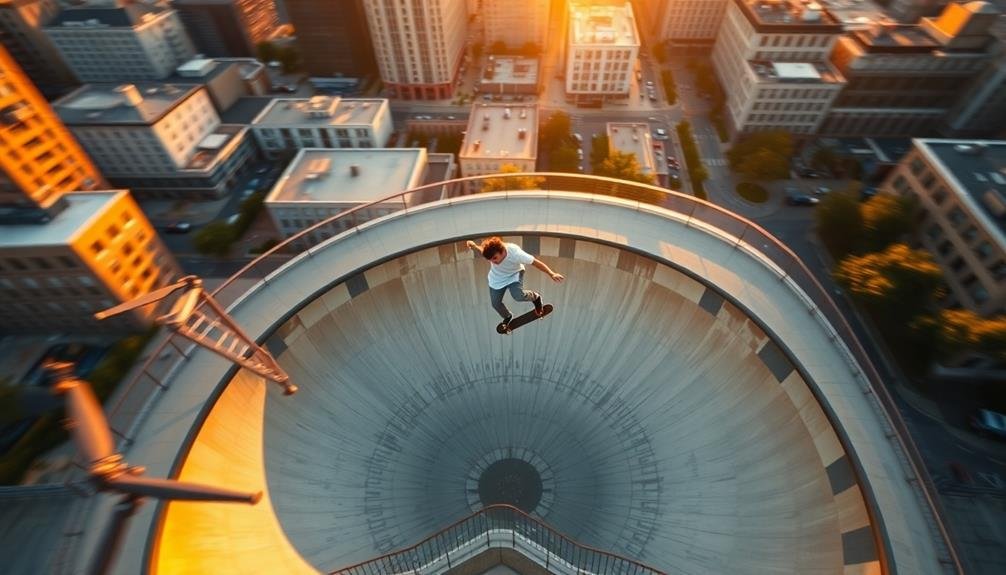



Leave a Reply